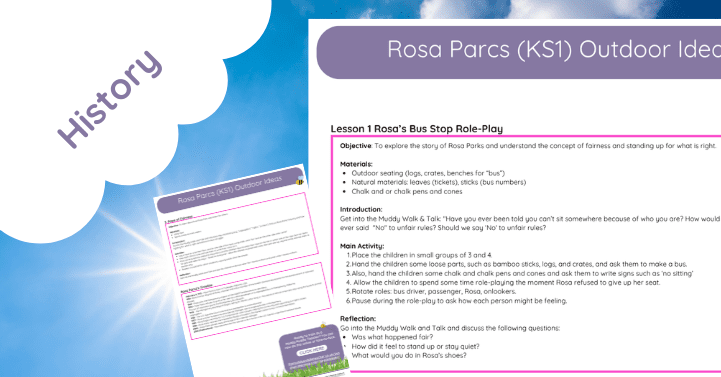Product Description: Outdoor Lesson Plan Ideas on The Transition to Farming and Settled Communities (Neolithic)
Transform your outdoor learning sessions with our engaging Outdoor Lesson Plan Ideas on The Transition to Farming and Settled Communities (Neolithic)! Designed for educators and Forest School leaders, this resource provides immersive, hands-on activities that bring the Neolithic era to life, helping students understand the pivotal shift from nomadic to settled lifestyles.
Key Features:
- Immersive Outdoor Learning:
- Dive into the Neolithic world with practical activities like planting crops, building shelters, and simulating trade markets.
- Cross-Curricular Integration:
- Seamlessly blends history, geography, science, and teamwork into each lesson.
- Hands-On Experiences:
- Activities include sowing seeds, constructing settlements, cooking Neolithic recipes, and understanding animal domestication.
- Adaptable for All Ages:
- Lessons are designed to be flexible and can be tailored to suit different age groups, abilities, and group sizes.
- Encourages Critical Thinking:
- Discussion prompts and reflection opportunities deepen students’ understanding of how farming transformed human society.
- Promotes Teamwork and Collaboration:
- Students work together to solve problems, build structures, and explore the challenges of early communities.
Ideal For:
- History teachers covering the Neolithic period in Key Stage 2.
- Forest School leaders are seeking meaningful historical and environmental activities.
- Outdoor educators are looking for innovative ways to teach about early human life.
Why Choose This Resource?
This resource helps students connect with history tangibly and memorably by combining historical accuracy with engaging, practical activities. From planting seeds to simulating trade, every lesson offers a unique opportunity to explore the ingenuity and resilience of early farming communities.
Bring the past to life and inspire curiosity with our Outdoor Lesson Plan Ideas on The Transition to Farming and Settled Communities (Neolithic)!
Engaging Special Educational Needs and Disabilities (SEND) students in practical, outdoor lessons on topics like the Neolithic transition to farming offers numerous educational and developmental benefits. Traditional classroom settings can sometimes present challenges for SEND students, such as sensory overload or limited opportunities for hands-on learning. Outdoor environments provide a dynamic alternative, fostering engagement and accommodating diverse learning needs.
Benefits of Outdoor Learning for SEND Students
- Enhanced Engagement: Outdoor settings offer sensory-rich experiences that can captivate students’ attention and cater to various learning styles. Activities like planting crops or building shelters allow students to connect theoretical knowledge with tangible experiences.
- Improved Social Skills: Collaborative tasks in outdoor lessons encourage communication and teamwork, helping SEND students develop essential social competencies.
- Reduced Anxiety: Natural environments can have a calming effect, reducing stress and anxiety levels, which is particularly beneficial for students who may find traditional classrooms overwhelming.
- Physical Development: Engaging in digging or constructing shelters promotes motor skills and overall physical health.
Implementing Practical Outdoor Lessons on Neolithic Farming
- Experiential Learning: Activities like planting seeds or simulating ancient farming techniques provide hands-on experiences that make historical concepts more accessible and memorable.
- Sensory Integration: Outdoor lessons naturally incorporate sensory elements—such as the texture of soil or the sounds of nature—that can be therapeutic and aid in sensory processing for SEND students.
- Inclusivity: Outdoor settings can be adapted to meet various physical and cognitive needs, ensuring that all students can participate meaningfully.
Supporting Research and Resources
- The Early Years Alliance highlights that outdoor play supports development and promotes well-being, especially for children with SEN.
- The National Trust’s Guardianship scheme demonstrates the effectiveness of hands-on outdoor activities in engaging SEND students with the national curriculum.
- Pentagon Play discusses how outdoor learning environments can help children with SEND develop communication and social skills in a stress-free setting.
- The Voice of Early Childhood emphasizes the therapeutic benefits of unhurried play in natural settings for children with SEND.
- The National Association for Environmental Education (NAEE) notes that Forest School programs offer practical learning opportunities that help SEND children develop life skills.
Conclusion
Integrating outdoor, practical lessons on historical topics like the Neolithic transition into educational programs for SEND students can lead to more inclusive, engaging, and effective learning experiences. By moving beyond the traditional classroom, educators can harness the benefits of nature to support the diverse needs of all learners.












